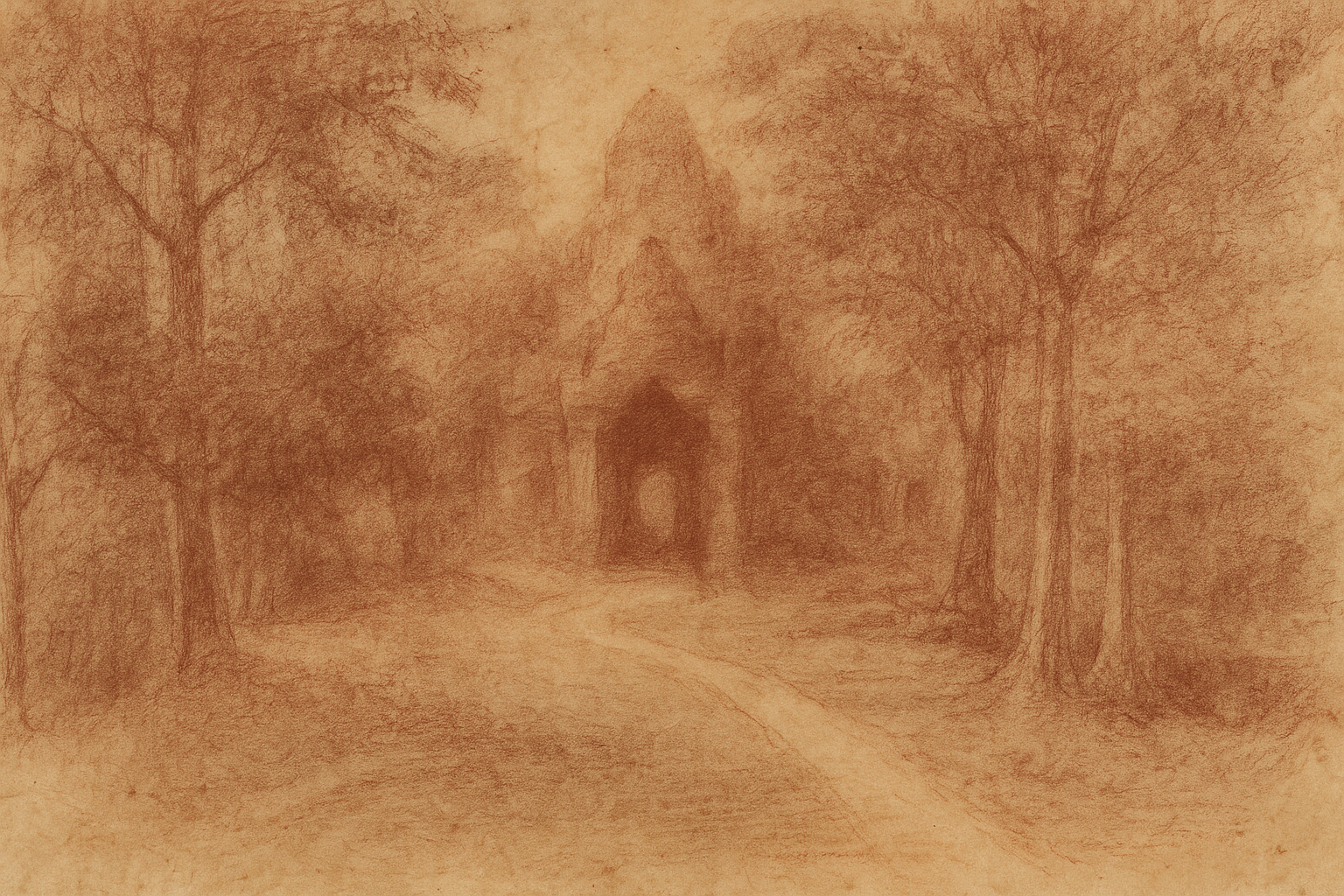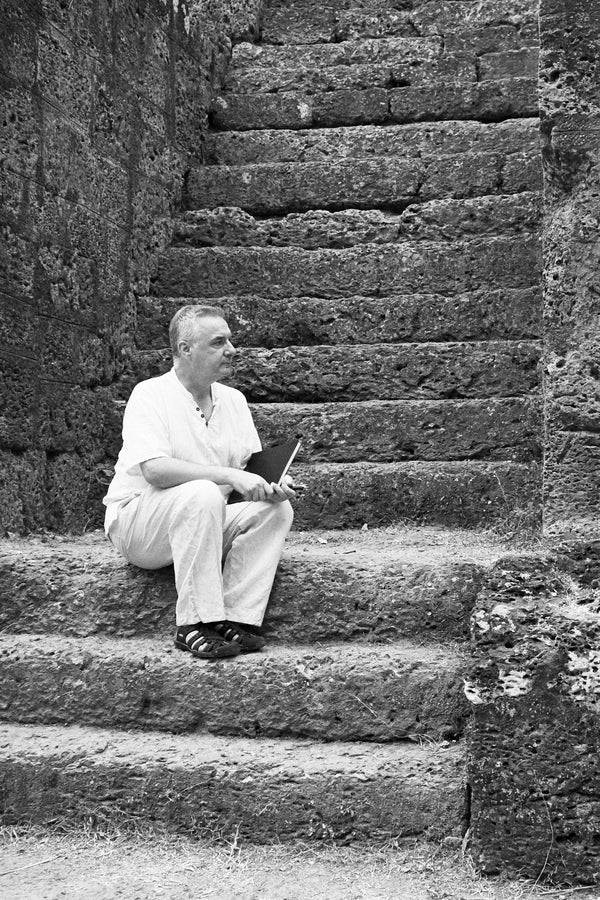Complimentary worldwide shipping on orders over $400 · No import tariffs for most countries
Complimentary worldwide shipping on orders over $400 · No import tariffs for most countries

The Gate the Ancestors Still Guard
Preah Khan · Southern Satellite Temple — July 2025
We walked in silence, but the stone remembered our names.
—
After the rains, the world exhaled.
The monsoon had passed in the night—slow thunder curling like incense across the surface of the Jayatataka baray—and by the time Annie and I returned to Preah Khan, the sky had become a veil of luminous cloud. No sun. Only breath. No shadow. Only hush.
We left our moto beside the eastern jetty, where the laterite stones gaze over the wide, still water. Far across the baray, Neak Poan floated like a memory—quiet on its island, a shrine unto itself. It was not difficult to imagine Jayavarman VII here, cloaked in white, stepping into a serpent-shaped barque to visit the centre of healing. Not as king, but as pilgrim.
The trail we followed curved through the southern forest where few footsteps fall. No road reaches here. Only a soft path of red earth, wet from the night’s rain, winding among roots and ferns. Our feet left gentle traces in the soil. Birds called from shadow. The trees stirred in half-sleep. And deeper in the stillness, something older kept watch.
The ruined causeway appeared like a vision half-remembered. Its balustrades had once been alive with colossal figures—devas and asuras churning the naga—but now, most had fallen. A few remain, their heads gone, their hands still gripping the serpent’s undulation as if the story could never end.
We passed between them quietly, as one passes between truths too vast to name.
—
The southern gopura of the third enclosure stood before us—weathered, remote, and strangely radiant. The pediment above the gate bore the scene of a celestial chariot: Vishnu—or Krishna—standing poised in glory, drawn by a single horse, his enemies falling beneath him. To the side, Agni mounted a rhinoceros. Varuna floated forward upon a great hamsa. Even the broken stone retained its strength, like a half-whispered chant still echoing beneath breath.
The dvarapalas who flanked the gate had no heads, but their stance remained—unyielding, unbowed.
I paused before them, and opened my sketchbook. But this was not observation. It was invitation. The chalk moved slowly, drawn not by hand but by presence. This carving, I felt, had waited years for someone to kneel and listen. Not with the eye, but with reverence.

Where the gods still battle, and silence watches
—
Through the gate, a chamber opened—roofless, ruined, strewn with fallen stone. There, in the hush of old incense and fern-shadow, rested the fragment of a great statue. A standing Buddha, now only torso and base, worn smooth by centuries of rain. Moss gathered in the folds of his robe. The light that fell upon him was not harsh, not theatrical—just soft, constant, and forgiving.
I knelt beside him and drew. Not his form, but his surrender. Not his grandeur, but his broken grace.
fragments in the moss—
soft light touching absent feet…
the prayer of ruin

A body broken, a presence still whole
—
The southern satellite temple lay beyond—silent, overgrown, and half-consumed by time. We stepped through lintelled thresholds and stumbled through rubble-strewn courtyards, the forest curling inward at every turn. Each doorway felt like an invitation deeper into memory. A lintel showed the Pigeon Jataka—Buddha seated above a worshipper holding scales, the bird below radiant and still. Another showed a bodhisattva tormented—his suffering carved so delicately it seemed to hum.
We emerged at last into a corridor running north to south, and in its perfect alignment we saw the doorway of the first enclosure opening toward the central stupa. The stupa stood distant, but exact—framed by light, worn smooth, yet unwavering. Its flanking dvarapalas stood in quiet equilibrium, as though guarding not the sanctuary, but the breath between moments.
I found a low stone and sat to draw. My hand moved as one tracing a chant in the air.
The chalk listened
more than I did—
lines remembering
what language forgot.
It was not a drawing,
but the ruin drawing breath,
and me with it.

Still the stupa waits, through everything lost
—
We circled slowly back, passing through shattered galleries and apsara-lined walls. In the western courtyards, the dancers still smiled—some with mischief, some with serenity—but all untouched by time’s impatience. Their beauty was not in symmetry, but in persistence. In stone still dancing, even now.
A narrow passage brought us at last to a dim chapel. Inside, the air shifted—cooler, charged, like breath held. Upon the far wall stood a devata so finely carved she seemed more apparition than stone. Her dress bloomed with floral patterns. Her eyes, long ago, had been set with gems. This was Queen Indradevi—beloved consort of Jayavarman, devoted Buddhist, luminous presence. A simple shrine had been built beneath her feet. Someone had left jasmine. Incense. Silence.
We bowed. No words passed between us. Only the smoke rose.
—
We returned by the way we came, the temple now bathed in a paler light. Brighter, but no less still. And though we said nothing, it felt as if we had spoken with something vast and unseen.
We, like the soft chalk, had left no mark.
We left no offering but silence, and the temple received it.
Sanctuary of the Sword and the Stillness
Photographs from Preah Khan Temple by Lucas Varro
Preah Khan is a temple of thresholds—built as both sanctuary and sword, palace and prayer. Once a centre of learning and devotion, its vast corridors unfold like a labyrinth of memory: lintels worn smooth by centuries of touch, roots winding through broken sanctums, light slipping like breath across the stones.
Constructed by Jayavarman VII to honour his father, Preah Khan holds within its crumbling grandeur a quiet tension—between ruin and reverence, conquest and compassion, emptiness and sacred trace. Here, silence gathers in chambers where dancers once swirled, and moonlight drapes across a still-standing stupa at the heart of the sanctuary.
In this contemplative collection from the Spirit of Angkor series, Lucas Varro brings his analogue cameras to the softened austerity of Preah Khan. Each photograph—captured on large or medium format black-and-white film, shaped by long exposure, chiaroscuro, and hand-toning—distils the temple’s presence into pure atmosphere. A devata faded but smiling. A doorway dissolving into mist. A single root embracing stone like prayer.
Printed in limited editions on museum-grade Hahnemühle Bamboo paper, each work is accompanied by a Collector’s Print Package including poetic writings, curatorial reflections, and field notes from the artist’s dawn pilgrimages through the temple’s sacred ruins.
This is Preah Khan not as relic, but as witness. A vast, breathing sanctum where stillness is the final inscription.
Join My Studio Journal
Receive occasional letters from my studio in Siem Reap—offering a glimpse into my creative process, early access to new fine art prints, field notes from the temples of Angkor, exhibition announcements, and reflections on beauty, impermanence, and the spirit of place.
No noise. No clutter. Just quiet inspiration, delivered gently.
Subscribe and stay connected to the unfolding story.

Join My Studio Journal
Receive occasional letters from my studio in Siem Reap—offering a glimpse into my creative process, early access to new fine art prints, field notes from the temples of Angkor, exhibition announcements, and reflections on beauty, impermanence, and the spirit of place.
No noise. No clutter. Just quiet inspiration, delivered gently.
Subscribe and stay connected to the unfolding story.































